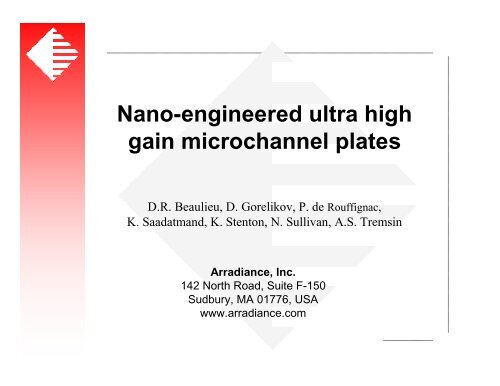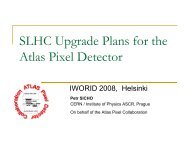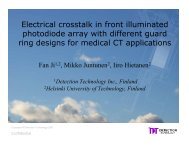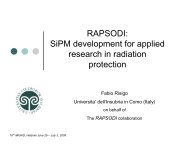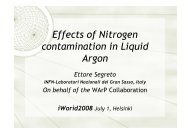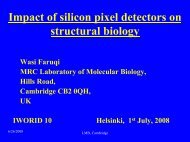Nano-engineered ultra high gain microchannel plates - Arradiance
Nano-engineered ultra high gain microchannel plates - Arradiance
Nano-engineered ultra high gain microchannel plates - Arradiance
Create successful ePaper yourself
Turn your PDF publications into a flip-book with our unique Google optimized e-Paper software.
<strong>Nano</strong>-<strong>engineered</strong> <strong>ultra</strong> <strong>high</strong><br />
<strong>gain</strong> <strong>microchannel</strong> <strong>plates</strong><br />
D.R. Beaulieu, D. Gorelikov, P. de Rouffignac,<br />
K. Saadatmand, K. Stenton, N. Sullivan, A.S. Tremsin<br />
<strong>Arradiance</strong>, Inc.<br />
142 North Road, Suite F-150<br />
Sudbury, MA 01776, USA<br />
www.arradiance.com
Present MCP technology<br />
Areas of MCP applications<br />
Glass-based structures, manufacturing<br />
Present limitations and drawbacks<br />
Previous alternative technologies<br />
Improvement of the glass MCP characteristics<br />
Gain<br />
Lifetime<br />
Ion feedback<br />
Novel substrate-independent manufacturing<br />
technology<br />
2<br />
IWORID10, July 2008<br />
<strong>Arradiance</strong>.com
Night vision goggles<br />
Mass spectroscopy<br />
Astrophysics<br />
Synchrotron<br />
instrumentation<br />
Biomedical research<br />
(FLIM, FRET,…)<br />
X-Ray and UV photon<br />
detection<br />
Neutron radiography<br />
and Bragg edge<br />
spectroscopy<br />
3<br />
IWORID10, July 2008<br />
<strong>Arradiance</strong>.com
Event counting<br />
Very low dark current<br />
Sensitivity to photons, ions, electrons neutrals,<br />
neutrons, alpha particles<br />
Simultaneous <strong>high</strong> spatial (~10 µm FWHM) and<br />
temporal (~100 ps FWHM) resolution<br />
Different geometries (e.g. hole in the middle)<br />
Solar blindness<br />
Large active area<br />
4<br />
IWORID10, July 2008<br />
<strong>Arradiance</strong>.com
Limited counting rate capabilities (
Circular-pore MCP<br />
Single pore<br />
V 1<br />
V 2<br />
6<br />
IWORID10, July 2008<br />
<strong>Arradiance</strong>.com
7<br />
IWORID10, July 2008<br />
<strong>Arradiance</strong>.com
Complex production technology;<br />
Both conduction and emission layer produced simultaneously<br />
and cannot be optimized independently.<br />
Large parameter deviation and low reproducibility;<br />
geometrical distortions unavoidable.<br />
Image spottiness;<br />
Not <strong>high</strong> temperature compatible;<br />
Limited lifetime;<br />
Small pore MCPs and large area MCPs are expensive to<br />
produce;<br />
Lead contamination;<br />
8<br />
IWORID10, July 2008<br />
<strong>Arradiance</strong>.com
Sub-µm pores in<br />
anodic alumina substrates<br />
Lithographically etched<br />
10 µm pores<br />
Initial attempts did not produce conformal coating.<br />
To date no fully functional MCP exists<br />
Good substrates,<br />
no continuous films<br />
9<br />
IWORID10, July 2008<br />
A. Govyadinov, et al., Nucl Instr. Meth. A 419 (1998) 667<br />
<strong>Arradiance</strong>.com
SEM image of the pore wall<br />
Holes are punched in thin films,<br />
which are laminated into thick structures<br />
10<br />
Very large pore sizes.<br />
Difficult to manufacture<br />
(stacking many substrates).<br />
Not suitable for imaging.<br />
IWORID10, July 2008<br />
Yi Whikun, et al., Rev. Sci. Instr. 71 (2000) 4165<br />
Gain vs. applied bias<br />
<strong>Arradiance</strong>.com
Pore pattern is set by photolithography<br />
CVD growth of conduction layer and emission layer<br />
2 kx 6 µm<br />
Full field UV image<br />
(stack of 4 MCPs).<br />
Residual distortions are seen<br />
Relatively low <strong>gain</strong>.<br />
No solid edge.<br />
Long term stability.<br />
11<br />
C.P. Beetz, et al., Nucl, Instr. Meth. A 442 (2000) 443<br />
IWORID10, July 2008<br />
Gain of 4 MCP stack (40:1 each)<br />
<strong>Arradiance</strong>.com
Improvement of the emission layer<br />
longer lifetime<br />
<strong>high</strong>er <strong>gain</strong><br />
reduced ion feedback<br />
<strong>Nano</strong>-<strong>engineered</strong> conduction and emission layers<br />
Novel MCP substrates (new glasses or micromachined)<br />
Better uniformity / spatial resolution<br />
Increased lifetime<br />
Novel photocathodes / opaque mode<br />
Withstand much <strong>high</strong>er processing temperature<br />
Very Low noise (no radioactive traces)<br />
12<br />
IWORID10, July 2008<br />
<strong>Arradiance</strong>.com
100000<br />
Applied over commercial glass MCPs:<br />
50:1 L/D, 4.8 µm pores, ~250 MΩ resistance<br />
10000<br />
880 V new<br />
880 V treated<br />
1000V new<br />
1000 V treated<br />
Gain<br />
1000<br />
100<br />
0.001 0.01 0.1 1<br />
I out (pA/pore)<br />
13<br />
IWORID10, July 2008<br />
5x-10x <strong>gain</strong> increase<br />
<strong>Arradiance</strong>.com
Full field illumination image.<br />
Test MCP is irradiated by a uniform<br />
electron flux.<br />
Photograph of the phosphor screen is<br />
shown.<br />
14<br />
IWORID10, July 2008<br />
<strong>Arradiance</strong>.com
Improved lifetime, Relaxed detector preconditioning<br />
1.2<br />
1.0<br />
Relative Gain<br />
0.8<br />
0.6<br />
0.4<br />
0.2<br />
Commercial MCP<br />
<strong>Arradiance</strong> Coated Commercial MCP<br />
50:1 L/D<br />
Bias 880 V<br />
18 mm active area<br />
4.8 µm pores<br />
R ~ 100-200 MΩ<br />
I out<br />
~ 10-20% I strip<br />
0.0<br />
0.000 0.010 0.020 0.030 0.040 0.050<br />
Extracted Dose, C/cm 2<br />
15<br />
IWORID10, July 2008<br />
Applied over commercial glass MCPs<br />
<strong>Arradiance</strong>.com
Revive aged MCP to <strong>high</strong> <strong>gain</strong> values<br />
12000<br />
Gain<br />
10000<br />
8000<br />
6000<br />
4000<br />
2000<br />
Uncoated MCP1<br />
Coated MCP1<br />
Coated MCP2<br />
50:1 L/D<br />
Bias 880 V<br />
18 mm active area<br />
4.8 µm pores<br />
R ~ 100-200 MΩ<br />
I out<br />
~ 10-20% I strip<br />
0<br />
0.000 0.050 0.100 0.150<br />
Dose, C/cm 2<br />
16<br />
IWORID10, July 2008<br />
Applied over commercial glass MCPs<br />
<strong>Arradiance</strong>.com
Can be applied to any substrate sustaining ~200 o C<br />
Conformal coating / large aspect ratio<br />
Micromachinned substrates<br />
No radioactive traces<br />
Separate control of conduction and emission<br />
properties<br />
Reduced ion emission / long life photocathodes<br />
17<br />
IWORID10, July 2008<br />
<strong>Arradiance</strong>.com
4.8 µm pore substrate, 50:1 L/D, R~170 MΩ,<br />
<strong>gain</strong> under electron bombardment<br />
18<br />
Gain<br />
100000<br />
10000<br />
1000<br />
100<br />
10<br />
1<br />
20<br />
700 800 900 1000<br />
IWORID10, July 2008<br />
MCP bias (V)<br />
Gain<br />
Resistance<br />
Stable resistance<br />
R (M Ω )<br />
Gain<br />
10000<br />
1000<br />
880V<br />
700V<br />
Typical exponential <strong>gain</strong> increase with bias<br />
200<br />
180<br />
160<br />
140<br />
120<br />
100<br />
Good <strong>gain</strong> ~ 14000 at 1000V<br />
80<br />
60<br />
40<br />
Good TCR (comparable to glass MCP values)<br />
100<br />
0.0001 0.001 0.01 0.1 1<br />
I out (pA/pore)<br />
<strong>Arradiance</strong>.com
4.8 µm pore substrate, 50:1 L/D, Bias = 880V,<br />
I out ~0.07 pA/pore, <strong>gain</strong> under electron bombardment<br />
3000<br />
2500<br />
2000<br />
Gain<br />
1500<br />
1000<br />
500<br />
0<br />
0 0.005 0.01 0.015<br />
Dose (C/cm 2 )<br />
Quickly reaches stable <strong>gain</strong><br />
19<br />
IWORID10, July 2008<br />
<strong>Arradiance</strong>.com
10 µm pore NO LEAD glass substrate, 40:1 L/D, R~280 MΩ,<br />
<strong>gain</strong> under electron bombardment<br />
1000000<br />
350<br />
10000<br />
Gain<br />
100000<br />
10000<br />
1000<br />
100<br />
Gain<br />
Resistance<br />
300<br />
250<br />
200<br />
150<br />
100<br />
50<br />
R (M Ω )<br />
Gain<br />
1000<br />
800V<br />
700V<br />
10<br />
0<br />
500 600 700 800 900 1000<br />
MCP bias (V)<br />
100<br />
0.001 0.01 0.1 1<br />
I out (pA/pore)<br />
20<br />
IWORID10, July 2008<br />
Stable resistance<br />
Typical exponential <strong>gain</strong> increase with bias<br />
Good <strong>gain</strong> ~ 40000 at 1000V bias<br />
Good TCR (comparable to glass MCP values)<br />
<strong>Arradiance</strong>.com
10 µm pore NO LEAD glass substrate, 40:1 L/D, Bias = 880V,<br />
I out ~0.4 pA/pore, <strong>gain</strong> under electron bombardment<br />
1.2<br />
1<br />
0.8<br />
Gain<br />
0.6<br />
0.4<br />
0.2<br />
0<br />
Commercial MCP<br />
<strong>Arradiance</strong> emissive film only<br />
<strong>Arradiance</strong> Conductive & Emissive films<br />
0 0.01 0.02 0.03 0.04 0.05<br />
Dose (C/cm 2 )<br />
21<br />
IWORID10, July 2008<br />
Quickly reaches stable <strong>gain</strong><br />
<strong>Arradiance</strong>.com
4.8 µm pore substrates, 50:1 L/D,<br />
<strong>gain</strong> under electron bombardment<br />
100000<br />
10000<br />
700 V<br />
880V<br />
1000V<br />
Gain<br />
1000<br />
100<br />
1.E-04 1.E-03 1.E-02 1.E-01<br />
I out (pA/pore)<br />
22<br />
IWORID10, July 2008<br />
Typical count rate saturation at output<br />
equal to ~10% of strip current<br />
<strong>Arradiance</strong>.com
Novel emission and conduction layers for MCP<br />
technology have been developed<br />
Emission layer improves the performance of glass<br />
MCPs<br />
High <strong>gain</strong><br />
Longer lifetime<br />
Reduced outgassing<br />
Substrate independent conduction and emission films<br />
open new possibilities<br />
Micromachinned substrates<br />
<strong>high</strong> T compatible<br />
Novel photocathode materials/configurations<br />
Low noise – no radioactive traces<br />
Better uniformity / reproducibility / spatial resolution<br />
23<br />
IWORID10, July 2008<br />
<strong>Arradiance</strong>.com


